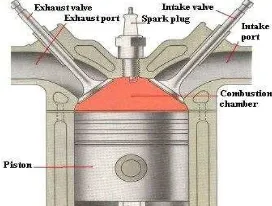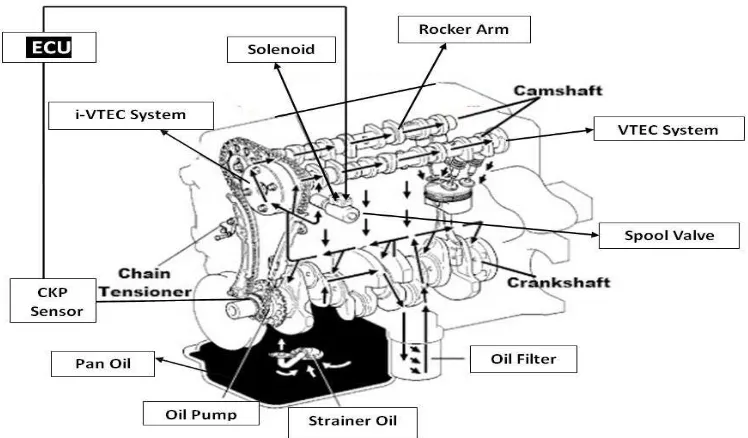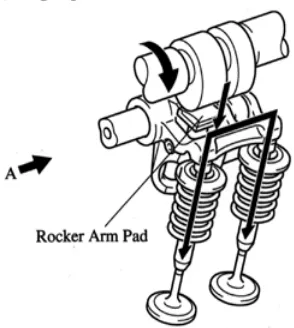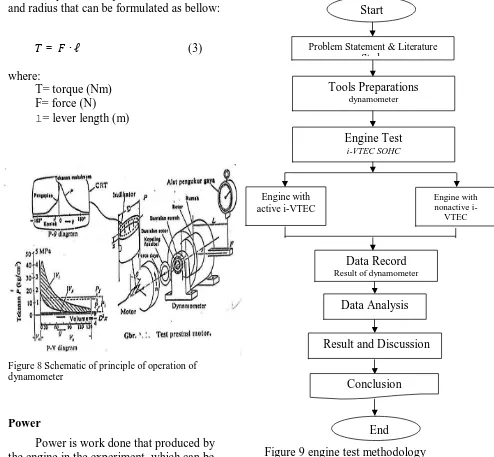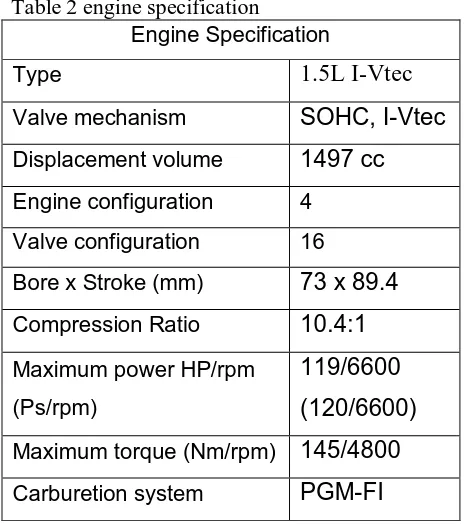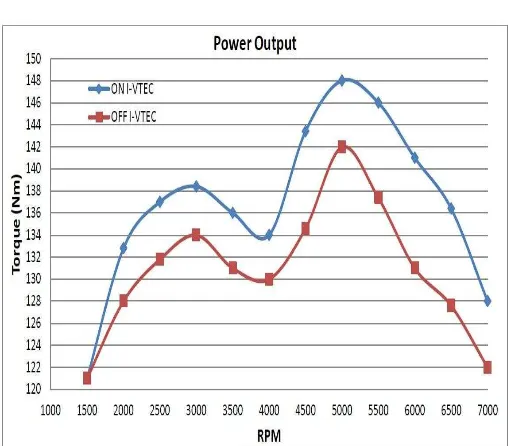PAPER
PUBLICATION ARTICLE
COMPARISON ANALYSIS PERFORMANCE OF
GASOLINE ENGINE USING i-VTEC SYSTEM
AND CONVENTIONAL ENGINE
The Paper of Final Project Seminar is submitted as a requirement to follow Final Project Examination in Automotive/Motorcycle Engineering Muhammadiyah
University of Surakarta
Arranged by :
FAIZAL HIDAYAT NIM : D200 080 203
MECHANICAL ENGINEERING DEPARTMENT
INTERNATIONAL PROGRAM
IN AUTOMOTIVE/MOTORCYCLE ENGINEERING
MUHAMMADIYAH UNIVERSITY OF SURAKARTA
1 COMPARISON ANALYSIS PERFORMANCE OF GASOLINE ENGINE USING
i-VTEC SYSTEM AND CONVENTIONAL ENGINE Ir. Subroto, MT.
Mechanical Engineering Department of Muhammadiyah University of Surakarta Jln. A. Yani Pabelan-Kartasura. Tromol Pos I Telp. (0271) 715448 Surakarta
Nur Akhlis, ST.
Mechanical Engineering Department of Muhammadiyah University of Surakarta Jln. A. Yani Pabelan-Kartasura. Tromol Pos I Telp. (0271) 715448 Surakarta
E-mail : [email protected]
Faizal Hidayat
Automotive Department of Muhammadiyah University of Surakarta Jln. A. Yani Pabelan-Kartasura. Tromol Pos I Telp. (0271) 715448 Surakarta
E-mail : [email protected]
ABSTRACT
Nowadays, many demands from consumers to have a car with powerful engine and low of gasoline so vehicle manufactures think how to make engine like that. Vehicle manufactures develop technology which can increase of performance and the engine can have a great power and torque. Intellegence Variable Timing and Lift Electronic Control (i-VTEC) can be used to problem solve above because it can control timing valve. I-VTEC can increase engine performance that can make the gasoline engine will increase power and torque.
Research target that is to know influence variable valve timing to engine performance at four stroke engine 1497cc. Research uses four stroke engine with two types of engine with active i-VTEC and engine with non-active i-VTEC. Two types of four stroke engine will testing above engine dynamometer. Calculation is conducted after got data of testing result.
Base testing and analysis can be concluded that engine use active i-VTEC have higher performance than engine with non-active i-VTEC. From dynamometer test was get maximum torque from engine use i-VTEC is 148 Nm at 5000 rpm and maximum torque from engine with non-active i-VTEC is 142 Nm at 5000 rpm. Maximum power from engine use active i-VTEC is 120.6 BHP at 6500 rpm and maximum power from engine with non-active i-VTEC is 115.2 BHP at 6500 rpm. I-VTEC organizes timing of valve which can make overlapping on the machine. Overlapping make number of air-fuel mixture in combustion chamber will increase which can make performance will increases.
Key words: gasoline engine, i-VTEC, performance, torque, power
BACKGROUND
Nowadays, many demands from consumers to have a car with powerful engine and low of gasoline so vehicle
2 Variable Timing and Lift Electronic Control
(i-VTEC) can be used to problem solve above because it can control timing valve. I-VTEC can increase efficiency volumetric that can make the gasoline engine will increase power and torque.
Basically the existing system on automobile combustion is complex. To generate maximum power at low RPM is required a different setting with if we want to generate maximum power at high RPM. This is because the properties of the mixture of air and fuel during combustion. How big the performance while in low RPM.
Intellegence Variable Timing and Lift Electronic Control is a generalized term used to describe any mechanism or method that can change the timing of valve lift event within an internal combustion engine. Vehicle manufacture have special name for his i-VTEC technology. For examples: VTEC, VVT-i, MIVEC, VANOS, etc.
I-VTEC is intellegence-VTEC. Honda introduced many new innovations in i-VTEC, but the most significant one is the addition of a variable valve opening overlap mechanism to the VTEC system. Named VTC for Variable Timing Control, the current (initial) implementation is on the intake camshaft and allows the valve opening overlap between the intake and exhaust valves to be continously varied during engine operation. This allows for a further refinement to the power delivery characteristics of VTEC, permitting fine-tuning of the mid-band power delivery of the engine.
PROBLEM STATEMENT
Problems statement that can be drawn from the problem above is how does the
effect of i-VTEC to the gasoline engines in engine performance.
OBJECTIVES
Investigate the torque that resulted by the engine use i-VTEC with the torque that resulted by engine with non i-VTEC.
Investigate the power that resulted by the engine use i-VTEC with the number octane of 98.
2. Machine that used is Honda All New Jazz i-VTEC RS 1.5 M/T.
3. The discussion is about the torque and power on engine use active VTEC and engine with non-active i-VTEC technology. manufactur’s most successful valve actuation system to date and saw broad implementation in production models. It was introduced in 2001 and uses continuosly variable intake valve timing and computer controlled management for optimized torque output and fuel efficiency.
3 environment. Honda develop valve
technology that name VTEC technology. Principle of the works is increase the amount of gas that is inserted into the cylinder with using engine speed to be correction factor.
Ewo Tarmedi and Ridwan Adam (2009) with topic efficiency volumetric on engine using variable valve timing. His research used Hyundai engine using CVVT system and conventional engine. In his research concluded that from analysis and calculation have different torque and power. It is because different efficiency volumetric among engine using CVVT and conventional engine.
Dhanil Sanjaya (2012), his topic of final project is about the comparison of engine performance of gassoline engine between VTEC system and conventional engine. The object of his research used Honda Jazz engine using VTEC system and conventional engine. Then, he concluded that the highest engine torque and power can be reached when the engine using VTEC system, better than using conventional engine.
FUNDAMENTAL THEORY Engine Performance Parameters
Pressure on the combustion chamber will influence of many parameters. That parameter is combustion, gasoline, volumetric efficiency, carburetors and etc.
Combustion
Combustion engine is one of the activator engines that utilize heat energy from combustion process becoming mechanic energy in the combustion chamber.
combustion on combustion chamber.
Figure 1 combustion on combustion chamber.
Actually, the compositions of fuel substances are carbon, hydrocarbon, nitrogen, sulfur, oxygen, ash, and moisture. The reaction in the combustion chamber between air and fuel can be composed of substances such as: Carbon, Hydrogen, Nitrogen, Sulfur, Oxygen and other elements such as ash and moisture. Octane number is a number that indicates the ability to survive against knocking gasoline. The greater the octane number of gasoline, the greater the ability to survive gasoline to knocking (detonation). With the reduction in intensity for this detonation, then the mixture of air and fuel compressed by the piston to the many, so that the motor power will be greater and the fuel consumption becomes more efficient.
Table 1. Gasoline Properties
Volumetric Efficiency
Volumetric Efficiency (η ) is one of the performance of motor fuel parameters to measure the effectiveness of air or air-fuel mixture that can be
Fuel Type ‘Premium’ Gasoline
‘Pertamax’ Gasoline Molecular formula C8H18 C10H24
Solubility in water Float float
Flash point -43 °C -43 °C
Auto ignition 246 °C 246 °C Density g/cm3
(60 °C)
0.7321 0.7362
Appearance Golden Blue
Octane Number 88 98
Energy Content 44.4 MJ/kg 34.8 MJ/L
4 sucked into the cylinder. The greater
volumetric efficiency means more air or air-fuel mixture into the cylinder so that the engine power output increases
Ideally, a mass of air equal to the density of atmospheric air times the displacement volume of the cylinder should be ingested for each cycle. However, because of the short cycle time available and the flow restrictions presented by the air cleaner, carburetor (if any), intake manifold, and intake valves, less than this ideal amount of air enters the cylinder. Volumetric efficiency is defined as:
Volumetric efficiency is the ratio of the actual air mass flow rate with air mass flow rate in ideal. In fact, the air actual which is entering into the combustion chamber is influenced by the pressure, humidity, and temperature in the surrounding. So, it will not be perfect.
At standard conditions, the density of air (ρ ) = 1.181 kg/m3 = 0.0739 lbm/ft3.
So, it can be defined as follows:
ρ
=
₀ carburetor and fuel-injection is same, preparation of the combustion charge. But in chase of carburetion fuel is atomized by processes relying on the air speed greater than fuel speed at the fuel nozzle, whereas, in fuel injection the fuel speed at the point of delivery is greater then the air speed to atomize the fuel.Modern gasoline injection system use engine sensor, a computer, and solenoid operated fuel injection to meter and inject the right amount of fuel into the engine cylinder.
An electronic control unit (ECU) or the computer receives electrical signal in the form of current or voltage from various sensor. it then use the stored data to operate the injector, ignation system and other engine relate devices. As a result, less unburned fuel leaves the engine emision and the vehicle will occur perface combustion.
5 Compression Ratio
Higher compression ratio increases the pressure and temperature of the working mixture which reduce the initial preparation phase of combustion and hence less ignition advance is needed. High pressure and tempera pintures of the compressed mixture also seed up the second phase of combustion.
Valve Type
The valves let the air/fuel mixture into the engine and the exhaust out of the engine. The camshaft uses lobes (called cams) that push against the valves to open them as the camshaft rotates; springs on the valves return them to their closed position. This is a critical job, and can have a great valve based on valve mechanism.
I-VTEC Engine Mechanism
I-VTEC is intellegence-VTEC. It consists of mixed between 2 technologies are VTEC and VTC. The i-VTEC system is a new engine utilizes Honda's VTEC technology, which adjusts valve timing and lift based on the engine's RPM, but adds VTC (Variable Timing Control) which continuously adjust the intake valve overlap depending on engine load.
The VTEC (Variable Valve Timing and Lift Electronic Control) is to control the valves at low and high speed. In the 16 valve
6 Figure 3 Construction of i-VTEC system
Construction of i-VTEC system
i-VTEC construction three major components they are ECU, CKP Sensor, and Solenoid and Spool Valve.
Electronic Control Unit (ECU)
Modern engines are controlled by computer which are called ECU (Electronic Control Unit). It controls the functions of the engine and allows a precise management of the engine’s operations using a variety of sensors. Where, the precision means that a better engine response and performance along with improved fuel consumption and pollution levels. In addition, the ECU uses signals from the crankshaft position sensor to detect the actual valve timing, thus providing feedback control to achieve the target valve timing.
Crankshaft Position Sensor (CKP) Crankshaft Position Sensor (CKP) is a sensor that works electronically where it functions to monitor or read the speed of rotation or position of the crankshaft. CKP sensor is usually found near to the belt cam or crank shaft itself. Then, the results from the CKP sensor readings will be sent to the ECU as an input.
Solenoid and Spool Valve
The system works that is the sensor sent by the ECU will activate the coil, so that when the coil gets supply voltage then the coil will turn into a magnetic field that will drive the piston. When the piston moves the oil can be directly through it.
The solenoid valve has a function as a door for the oil which is through in the pipeline. It is commanded by the ECU to open or close. A valve that controls the direction of hydraulic fluid flow. A spool valve consists of cylindrical spools that alternately block and open channels in the hydraulic system.
7 arm displacement does not happen like what
to expect.
Operation of i-VTEC VTEC System
a. Stage 1 (Low Speed)
The 2 pieces of rocker arms move independently. Therefore the lift rocker arm, which actuates the left inlet valve, is driven by the low-lift left cam. The right rocker arm, which actuates the right inlet valve, is driven by the medium-lift right cam. Both cam timing are relatively slow compare with the middle cam, with actuates on valve.
Figure 4 Shown the mechanism at low speed.
b. Stage 2 (High Speed)
Hydraulic pressure locks all 2 rocker arms together. Since the middle cam is the largest, both inlet valves are actually driven by that fast cam. Therefore, fast timing and high lift are obtained in bot valves.
Figure 5 Shown the mechanism at high speed
i-VTEC System
The i-VTEC mechanism has 2 conditions are the Advance and the Retard.
a. Advance
When the camshaft timing oil control valve is positioned by the advance signal from the ECU, the resultant oil pressure is applied to the timing advance side vane chamber to rotate the camshaft in the timing advance direction.
Figure 6 Mechanism of Advance Condition
b. Retard
When the camshaft timing oil control valve is positioned as illustrated below by the retard signal from the ECM, the resultant oil pressure is applied to the timing retard side vane chamber to rotate the camshaft in the timing retard direction.
8 Parameter Of Engine Performance
Torque
Torque is multiplication between force and radius that can be formulated as bellow:
= ∙ ℓ (3)
where:
T= torque (Nm) F= force (N)
l= lever length (m)
Figure 8 Schematic of principle of operation of dynamometer
Power
Power is work done that produced by the engine in the experiment, which can be formulated as bellow:
= 2∙ ∙ ∙ (4) where:
bp = Break Power (bhp) n = engine rotation (rpm) T = torque (Nm)
ENGINE TEST METHODOLOGY
Figure 9 engine test methodology
Tools Preparation
In the experiment, material that used is spark ignition four-stroke engines with the volume of cylinder 1497cc, four cylinder, and vertical engines types, that connected to the dynamometer. The specification of engine can be seen as follow:
Start
Tools Preparations dynamometer
Problem Statement & Literature Study
Engine Test i-VTEC SOHC
Data Record Result of dynamometer
Engine with active i-VTEC
Engine with nonactive
i-VTEC
Result and Discussion
Conclusion
9 Table 2 engine specification
Engine Specification
Type 1.5L I-Vtec
Valve mechanism SOHC, I-Vtec
Displacement volume 1497 cc
Engine configuration 4
Valve configuration 16
Bore x Stroke (mm) 73 x 89.4
Compression Ratio 10.4:1
Maximum power HP/rpm
(Ps/rpm)
119/6600
(120/6600)
Maximum torque (Nm/rpm) 145/4800
Carburetion system PGM-FI
Dynamometer
The dynamometer will be used is digital dynamometer. The output of engine performance parameter is shown by graphic on display. The parameter will be shown are rotation, power and torque. Here the scheme of the dynamometer that used in the research.
Figure 10 dynamometer tool
Legend: 1. Monitor
2. Pick up coil sensor 3. Pick up coil roller
4. Dyno GUI ( graphic user interface ) console
5. Monitor 2
6. CPU 7. Printer
Engine test
Tools preparation step is conducted to prepare the entire tools that are used in the test. First step, prepare the tools which is honda jazz engine with i-VTEC. Test of performance honda jazz engine with SOHC i-VTEC on dyno test. After that give trouble on ECU to make i-VTEC on the honda jazz engine does not work so there is no signal and the hydrolic oil to solenoid cannot move and the pin on cam also does not working. Pull out one of sensor cable to make trouble on ECU, for example pull out cable of crankshaft position sensor. Then, test of performance jazz engine with non-active i-VTEC on dyno test.
Data Record
1. Power and torque can be obtained by running car on dynamometer. The procedure of data acquisition must be followed. First of all, riding the car just like in the normal condition until reach 4rd gear. After that, hold the engine speed in the number of 4000 rpm. Once it has reached 4000 rpm turn the handle fully until it reaches 7,000 rpm. After it has reached 7,000 rpm, back rotation to 4000 rpm again.
2. The output data can be read on the monitor that connect to dynamometer.
10 ANALYSIS
1. Engine Torque
Figure 11 Graphic of Torque Toward RPM
Figure 11 as shown in the figure the highest torque can be reached when the engine use i-VTEC system. The highest torque reaches the number of 148.0 N.m when the engine at 5000 rpm. On the other hand, if engine with non-active i-VTEC system, the high torque points the number of 142.0 N.m at 5000 rpm.
2. Engine Power
Figure 12 Graphic of Power Toward RPM
Figure 12 as shown in the figure the highest power for engine use i-VTEC can be reached on 120.6 HP when the engine at 6500 rpm. On the other hand, if engine with non-active i-VTEC system, the highest torque can be reached on 115.2 HP at 6500 rpm.
DISCUSSION
From the dynamometer test result, it can be know that torque and power from engine with i-VTEC system is biggest than engine with non-active i-VTEC system. It is because efficiency volumetric from gasoline engine with active i-VTEC technology was increase. I-VTEC system organizes timing of valve which can make overlapping more increase on the machine. It is because overlapping make number of air mass on cylinder will increase.
Volumetric efficiencies can be improved in a number of ways, but most notably the size of the valve openings compared to the volume of the cylinder and streamlining the ports. Engines with higher volumetric efficiency will generally be able to run at higher speeds (commonly measured in RPM) and produce more overall power due to less parasitic power loss moving air in and out of the engine.
CONCLUSION
a. The highest engine torque can be reached when the engine use i-VTEC. Maximum torque from engine use active i-VTEC is 148 Nm at 5000 rpm and maximum torque from engine with non-active i-VTEC is 142 Nm at 5000 rpm. Power will increase if the engine using i-VTEC system.
11 at 6500 rpm and maximum power from
engine with non-active i-VTEC system is 115.2 bhp at 6500 rpm. Power will increase if the engine using i-VTEC system.
BIBLIOGRAPHY
Ganesan, V, 2003. Internal Combustion
Engine Second Edition. Tata
McGraw-Hill. New Delhi.
Hacisevki, Hasan. 2009. Valve and Valve
Mechanisms.pdf. Eastern
Mediterranean University.
Pulkrabek Willard W, 2004, Engineering
Fundamentals of The Internal
Combustion Engine 2nd Edition,
Prentice Hall, New Jersey.
Sanjaya, Dhanil. 2012. Comparison Analysis
Performance Of Honda Jazz Using Active VTEC System And Non-Active VTEC System Engine. Final Project.
Universitas Muhammadiyah Surakarta.
Subowo, Heri. 2010. Perkembangan Teknologi Mekanisme Katup Pada Mesin Mobil. Tesis. Malang: Program
Pascasarjana Universitas Negeri Malang.
Tarmedi, Ewo dan Noor, Ridwan Adam M. 2009. Analisis Efisiensi Volumetric
Pada Motor Otto dengan
Menggunakan Variable Valve Timing.
